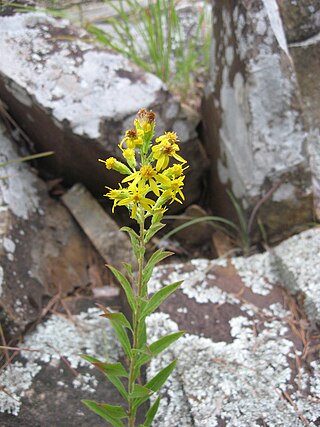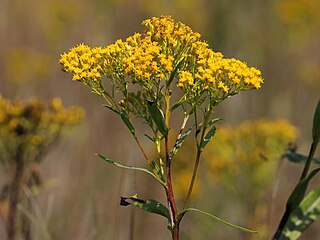
Solidago flexicaulis, the broadleaved goldenrod, or zigzag goldenrod, is a North American species of herbaceous perennial plants in the family Asteraceae. It is native to the eastern and central parts of the United States and Canada, from Nova Scotia west to Ontario and the Dakotas, and south as far as Alabama and Louisiana. It grows in a variety of habitats including mesic upland forests, well drained floodplain forests, seepage swamp hummocks, and rocky woodlands.

Solidago nemoralis is a species of flowering plant in the family Asteraceae. It is native to North America, where it is widely found in Canada and the United States. Its common names include gray goldenrod, gray-stem goldenrod, old-field goldenrod, field goldenrod, prairie goldenrod, dwarf goldenrod, and dyersweed goldenrod.

Solidago gigantea is a North American plant species in the family Asteraceae. Its common names include tall goldenrod and giant goldenrod, among others.
Solidago guiradonis is an uncommon species of goldenrod known by the common name Guirado goldenrod. It is native to the Central California Coast Ranges of central California, in southern San Benito and western Fresno Counties.

Solidago multiradiata is a species of goldenrod known by the common names Rocky Mountain goldenrod, northern goldenrod, and alpine goldenrod. It is native to North America, where it can be found throughout the northern regions, including Alaska and most of Canada (all 3 territories plus all provinces except Prince Edward Island, including territory north of the Arctic Circle. Its distribution extends through the western United States as far south as Arizona, New Mexico, and California. It is known mostly from the subalpine and alpine climates of high mountain ranges. Its habitat includes tundra and mountain meadows.

Solidago spectabilis is a species of goldenrod known by the common names Nevada goldenrod, basin goldenrod, and showy goldenrod. It is native to the western United States in the Great Basin and surrounding areas. It is found in California, Arizona, Nevada, Oregon, and Utah. There are historical records saying it once grew in southwestern Idaho, but is now extirpated there. This variety has also been seen in the western Montana county of Sanders.

Solidago houghtonii is a rare North American species of flowering plant in the family Asteraceae known as Houghton's goldenrod. It is native to southern Ontario, Canada and the northern United States. It is threatened by the loss and degradation of its habitat. It is a federally listed threatened species of the United States and it is designated a species of special concern by Canada's Committee on the Status of Endangered Wildlife in Canada.

Solidago missouriensis is a species of flowering plant in the family Asteraceae known by the common names Missouri goldenrod and prairie goldenrod. It is native to North America, where it is widespread across much of Canada, the United States, and northern Mexico. It grows from British Columbia east to Manitoba, south as far as Sonora, Coahuila, Texas, and Mississippi.

Solidago odora, the sweet goldenrod, anisescented goldenrod or fragrant goldenrod, is a North American species of goldenrod within the family Asteraceae. The plant is native to the United States and Mexico, found in every coastal state from Veracruz to New Hampshire and as far inland as Ohio, Missouri, and Oklahoma. It flowers from July through October.

Solidago velutina, the threenerve goldenrod or velvety goldenrod, is a plant species native to Mexico and to the western United States. The species has been found in southwestern Oregon, east to the Black Hills of South Dakota, and as far south as México State in the central part of the Republic of México. It is classified as a member of Subsection Nemorales.

Solidago ludoviciana, the Louisiana goldenrod, is a North American plant species in the family Asteraceae native to Louisiana, Texas and Arkansas. It can be found in dry open woods and along roadsides and other sunny, disturbed locations.
Solidago juliae, known as Julia's goldenrod, is a plant native to central and western Texas, as well as southern Arizona, Chihuahua, Coahuila and Nuevo León. It occurs in grasslands, woodlands, and on freshwater shores.

Solidago petiolaris is a North American species of goldenrod commonly called the downy ragged goldenrod. It is native to the United States and Mexico, in every coastal state from Texas to North Carolina, inland as far as southern Illinois, southern Nebraska, northeastern New Mexico, and Coahuila. Its preferred habitat is sandy areas.
Ageratina wrightii is a North American species of plants in the family Asteraceae. It is native to the southwestern United States and northern Mexico.

Solidago simplex, the Mt. Albert goldenrod or sticky goldenrod, is a North American plant species in the genus Solidago of the family Asteraceae. It is widespread across much of Canada, parts of the United States, and northeastern Mexico.
Solidago brachyphylla is a North American species of flowering plant in the family Asteraceae known by the common name Dixie goldenrod. It is native to the southeastern United States, from southern Mississippi to the Carolinas.

Solidago curtisii, commonly called Curtis' goldenrod and mountain decumbent goldenrod, is a North American species of flowering plants in the family Asteraceae. It is the eastern part of the United States from Pennsylvania to Mississippi and Alabama, primarily in the southern Appalachian Mountains.

Solidago mollis is a North American species of flowering plant in the family Asteraceae known by the common names velvety goldenrod, soft goldenrod or Ashly goldenrod. It is native to the central United States and central Canada, primarily the Great Plains from the Canadian Prairie Provinces south as far as Texas and New Mexico.

Solidago nana is a North American plant species in the family Asteraceae, with the common names baby goldenrod and dwarf goldenrod. The species is native to deserts and mountainsides in the western United States, from the Rocky Mountains to the Great Basin in the states of Idaho, Montana, Nevada, Utah, Wyoming, Colorado, Arizona, and New Mexico.

Solidago sect. Ptarmicoidei is a section of flowering plants in the genus Solidago. They are sometimes considered a separate genus: Oligoneuron. Like related species they are known as goldenrods. This section contains seven species of perennial herbs, all native to North America. They are distinguished from other goldenrods by their corymbiform flowerheads, which are flat or rounded in profile and about as broad as tall or broader, for which they are sometimes called flat-topped goldenrods.


















